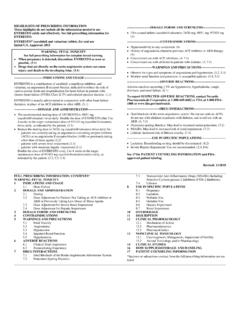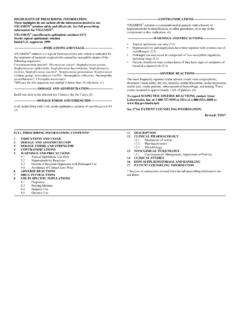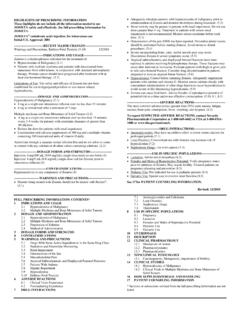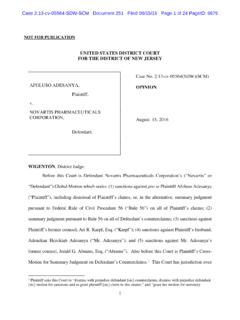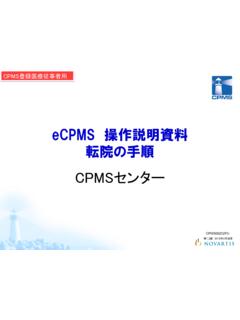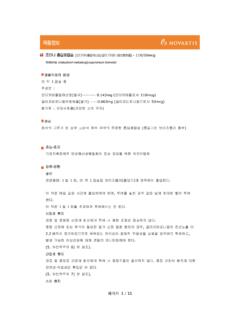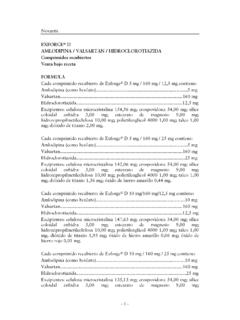Transcription of HIGHLIGHTS OF PRESCRIBING INFORMATION ... - Novartis
1 HIGHLIGHTS OF PRESCRIBING INFORMATION These HIGHLIGHTS do not include all the INFORMATION needed to use TASIGNA safely and effectively. See full PRESCRIBING INFORMATION for TASIGNA. TASIGNA (nilotinib) capsules, for oral use Initial Approval: 2007 WARNING: QT PROLONGATION AND SUDDEN DEATHS See full PRESCRIBING INFORMATION for complete boxed warning. Tasigna prolongs the QT interval. Prior to Tasigna administration and periodically, monitor for hypokalemia or hypomagnesemia and correct deficiencies ( ). Obtain ECGs to monitor the QTc at baseline, seven days after initiation, and periodically thereafter, and following any dose adjustments ( , , , ). Sudden deaths have been reported in patients receiving Tasigna ( ). Do not administer Tasigna to patients with hypokalemia, hypomagnesemia, or long QT syndrome (4, ).
2 Avoid use of concomitant drugs known to prolong the QT interval and strong CYP3A4 inhibitors ( , ). Avoid food 2 hours before and 1 hour after taking the dose ( ). --------------------------RECENT MAJOR CHANGES---------------------------- Indications and Usage, Pediatric Patients ( , ) 3/2018 Dosage and Administration, Pediatric Patients ( , ) 3/2018 Dosage and Administration, Discontinuation of treatment after a sustained molecular response ( ) on Tasigna ( ) 12/2017 Dosage and Administration, Reinitiation of treatment in patients who lose molecular response after discontinuation of therapy with Tasigna ( ) 12/2017 Warnings and Precautions, Hepatotoxicity ( ) 3/2018 Warnings and Precautions, Adverse Growth and Development ( ) 3/2018 Warnings and Precautions, Embryo-fetal toxicity ( )
3 12/2017 Warnings and Precautions, Monitoring of BCR-ABL transcript levels ( ) 12/2017 ----------------------------INDICATIONS AND USAGE-------------------------- Tasigna is a kinase inhibitor indicated for the treatment of: Adult and pediatric patients greater than or equal to 1 year of age with newly diagnosed Philadelphia chromosome positive chronic myeloid leukemia (Ph+ CML) in chronic phase. ( ) Adult patients with chronic phase (CP) and accelerated phase (AP) Ph+ CML resistant to or intolerant to prior therapy that included imatinib. ( ) Pediatric patients greater than or equal to 1 year of age with Ph+ CML-CP resistant or intolerant to prior tyrosine-kinase inhibitor (TKI) therapy. ( ) --------------------------DOSAGE AND ADMINISTRATION-------------------- Recommended Adult Dose: Newly diagnosed Ph+ CML-CP: 300 mg orally twice daily.
4 Resistant or intolerant Ph+ CML-CP and CML-AP: 400 mg orally twice daily. ( ) Recommended Pediatric Dose: Newly Diagnosed Ph+ CML-CP or Ph+ CML-CP resistant or intolerant to prior TKI therapy: 230 mg/m2 orally twice daily, rounded to the nearest 50 mg dose (to a maximum single dose of 400 mg). ( ) See Dosage and Administration ( ) for full dosing instructions and dose-reduction instructions for toxicity. Reduce starting dose in patients with baseline hepatic impairment. ( ) Eligible newly diagnosed adult patients with Ph+ CML-CP who have received Tasigna for a minimum of 3 years and have achieved a sustained molecular response ( ) and patients with Ph+ CML-CP resistant or intolerant to imatinib who have received Tasigna for at least 3 years and have achieved a sustained molecular response ( ) may be considered for treatment discontinuation.
5 ( , , ) ---------------------------DOSAGE FORMS AND STRENGTHS---------------- Capsules: 50 mg, 150 mg and 200 mg (3) ---------------------------------CONTRAI NDICATIONS---------------------------- Tasigna is contraindicated in patients with hypokalemia, hypomagnesemia, or long QT syndrome. (4) --------------------------WARNINGS AND PRECAUTIONS--------------------- Myelosuppression: Monitor CBC during therapy and manage by treatment interruption or dose-reduction. ( ) Cardiac and Arterial Vascular Occlusive Events: Evaluate cardiovascular status, monitor and manage cardiovascular risk factors during Tasigna therapy. ( ) Pancreatitis and elevated serum lipase: Monitor serum lipase; if elevations are accompanied by abdominal symptoms, interrupt doses and consider appropriate diagnostics to exclude pancreatitis.
6 ( ) Hepatotoxicity: Monitor hepatic function tests monthly or as clinically indicated. ( ) Electrolyte abnormalities: Tasigna can cause hypophosphatemia, hypokalemia, hyperkalemia, hypocalcemia, and hyponatremia. Correct electrolyte abnormalities prior to initiating Tasigna and monitor periodically during therapy. ( ) Tumor lysis syndrome: Maintain adequate hydration and correct uric acid levels prior to initiating therapy with Tasigna. ( ) Hemorrhage: Hemorrhage from any site may occur. Advise patients to report signs and symptoms of bleeding and medically manage as needed. ( ) Fluid retention: Monitor patients for unexpected rapid weight gain, swelling, and shortness of breath. Manage medically. ( ) Effects on Growth and Development in Pediatric Patients: Monitor growth and development in pediatric patients.
7 ( ) Embryo-Fetal toxicity: Advise patients of potential risk to a fetus and to use effective contraception. ( , , ) Treatment Discontinuation: Patients must have typical BCR-ABL transcripts. An FDA-authorized test with a detection limit below must be used to determine eligibility for discontinuation. Patients must be frequently monitored by the FDA authorized test to detect possible loss of remission. ( ) -----------------------------------ADVER SE REACTIONS-------------------------- The most commonly reported non-hematologic adverse reactions ( 20%) in adult and pediatric patients were nausea, rash, headache, fatigue, pruritus, vomiting, diarrhea, cough, constipation, arthralgia, nasopharyngitis, pyrexia, and night sweats. Hematologic adverse drug reactions include myelosuppression: thrombocytopenia, neutropenia and anemia.
8 ( ) To report SUSPECTED ADVERSE REACTIONS, contact Novartis Pharmaceuticals Corporation at 1-888-669-6682 or FDA at 1-800-FDA-1088 or -----------------------------------DRUG INTERACTIONS-------------------------- Strong CYP3A inhibitors: Avoid concomitant use with Tasigna, or reduce Tasigna dose if co-administration cannot be avoided. ( ) Strong CYP3A inducers: Avoid concomitant use with Tasigna. ( ) Proton Pump Inhibitors: Use short-acting antacids or H2 blockers as an alternative to proton pump inhibitors ( ) ------------------------------USE IN SPECIFIC POPULATIONS----------------- Lactation: Advise women not to breastfeed. ( ) See 17 for PATIENT COUNSELING INFORMATION and Medication Guide. Revised: 7/2018 FULL PRESCRIBING INFORMATION : CONTENTS* WARNING: QT PROLONGATION AND SUDDEN DEATHS 1 INDICATIONS AND USAGE Adult and Pediatric Patients with Newly Diagnosed Ph+ CML-CP Adult Patients with Resistant or Intolerant Ph+ CML-CP and CML-AP Pediatric Patients with Resistant or Intolerant Ph+ CML-CP 2 DOSAGE AND ADMINISTRATION Recommended Dosing Discontinuation of treatment after a sustained molecular response ( ) on Tasigna Reinitiation of treatment in patients who lose molecular response after discontinuation of therapy with Tasigna.
9 Dosage Modification for QT Interval Prolongation Dosage Modifications for Myelosuppression Dosage Modification for Other Non-Hematologic Toxicities Dosage Modification for Hepatic Impairment Dosage Modification with Concomitant Strong CYP3A4 Inhibitors 3 DOSAGE FORMS AND STRENGTHS 4 CONTRAINDICATIONS 5 WARNINGS AND PRECAUTIONS Myelosuppression QT Prolongation Sudden Deaths Cardiac and Arterial Vascular Occlusive Events Pancreatitis and Elevated Serum Lipase Hepatotoxicity Electrolyte Abnormalities Tumor Lysis Syndrome Hemorrhage Total Gastrectomy Lactose Monitoring Laboratory Tests Fluid Retention Effects on Growth and Development in Pediatric Patients Embryo-Fetal Toxicity Monitoring of BCR-ABL Transcript Levels 6 ADVERSE REACTIONS Clinical Trials Experience Postmarketing Experience 7 DRUG INTERACTIONS Effect of Other Drugs on Tasigna Drugs that Prolong the QT Interval 8 USE IN SPECIFIC POPULATIONS Pregnancy Lactation Females and Males of Reproductive Potential Pediatric Use Geriatric Use Cardiac Disorders Hepatic Impairment 10 OVERDOSAGE 11 DESCRIPTION 12 CLINICAL PHARMACOLOGY Mechanism of Action Pharmacodynamics Pharmacokinetics Pharmacogenomics 13 NONCLINICAL TOXICOLOGY Carcinogenesis, Mutagenesis.
10 Impairment of Fertility 14 CLINICAL STUDIES Adult Newly Diagnosed Ph+ CML-CP Adult Patients with Resistant or Intolerant Ph+ CML-CP and CML-AP Treatment discontinuation in newly diagnosed Ph+ CML-CP patients who have achieved a sustained molecular response ( ) Treatment discontinuation in Ph+ CML-CP patients who have achieved a sustained molecular response ( ) on Tasigna following prior imatinib therapy Pediatric Patients with Newly Diagnosed Ph+ CML-CP or Resistant or Intolerant Ph+ CML-CP 16 HOW SUPPLIED/STORAGE AND HANDLING 17 PATIENT COUNSELING INFORMATION * Sections or subsections omitted from the full PRESCRIBING INFORMATION are not listed FULL PRESCRIBING INFORMATION WARNING: QT PROLONGATION AND SUDDEN DEATHS Tasigna prolongs the QT interval.
